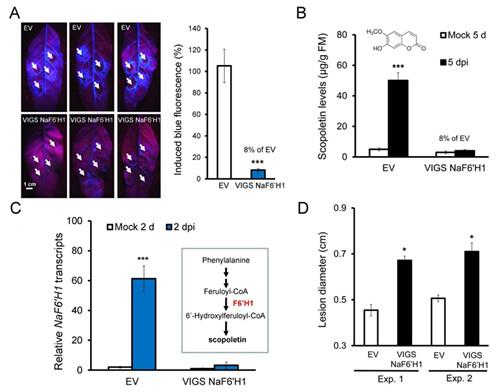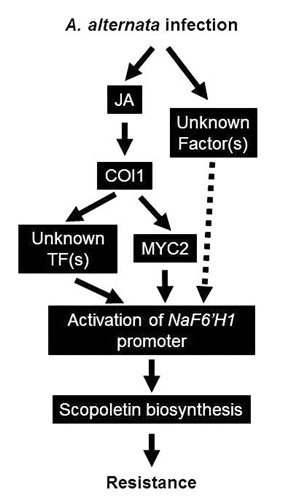
Scopoletin is a Phytoalexin Against Alternaria Alternata in Wild Tobacco Dependent on JA Signaling
Jun 04, 2014 Email"> PrintText Size

Alternaria alternata (tobacco pathotype) is a necrotrophic fungus that infects mature tobacco leaves and causes the so called Brown-spot disease which results in severe losses in Nicotiana species.
Until now most studies about plant-pathogen interaction have either focused on the regulating roles of several phytohormone pathways such as JA, SA, ET which are commonly strongly activated after fungal attack, or investigated secondary metabolites like scopoletin and capsidiol and their antimicrobial functions after infections. However, connections between plant signaling and the induction of secondary metabolites were lacking.
Prof. WU Jinsong and his master student SUN Huanhuan from Kunming Institute of Botany (KIB) found that young leaves of wild tobacco Nicotiana attenuata were more resistant to A. alternata than mature ones, and this was correlated with stronger blue fluorescence (indicating the accumulation of certain defense metabolites) induced after infection. However, the nature of the fluorescence-emitting compound, its role in defense and regulation were not clear.
Silencing feruloyl-CoA 6’-hydroxylase 1 (F6’H1) the key enzyme gene for scopoletin biosynthesis by virus-induced gene silencing (VIGS) revealed that the blue fluorescence was largely emitted by scopoletin and its ß-glycoside form, scopolin. Further analysis showed that scopoletin exhibited strong antifungal activity against A. alternata in vitro and in vivo. Importantly, JA levels were highly elicited in young leaves but much less in mature ones after infection and fungus-elicited scopoletin was abolished in JA deficient plants, but largely restored with methyl jasmonate treatments. Consistently, plants strongly impaired for JA biosynthesis and perception were highly susceptible to A. alternata. Furthermore, silencing MYC2, a master regulator of most JA responses, reduced A. alternata-induced NaF6’H1 transcripts and scopoletin. Thus, Prof. WU concluded that JA signaling is activated in N. attenuata leaves after infection, which subsequently regulates scopoletin biosynthesis for the defense against A. alternata partly through MYC2, and higher levels of scopoletin accumulated in young leaves account for their strong resistance.
The story was published under the title “Scopoletin is a phytoalexin against Alternaria alternata in wild tobacco dependent on JA signaling” in the Journal of Experimental Botany. The project is supported by the Chinese Academy of Sciences, and the Scientific Research Foundation of the Ministry of Education of China for Returned Scholars to WU Jinsong .

Fig.1 Silencing NaF6’H1 dramatically reduced A. alternata-elicited blue fluorescence and scopoletin, and plant resistance (Image by KIB)

Fig.2 A. alternata-induced JA is required for the fungus-elicited scopoletin production. (Image by KIB)

Fig.3 Working model of the regulation of A. alternata-induced scopoletin production by JA signaling. (Image by KIB)
Alternaria alternata (tobacco pathotype) is a necrotrophic fungus that infects mature tobacco leaves and causes the so called Brown-spot disease which results in severe losses in Nicotiana species.
Until now most studies about plant-pathogen interaction have either focused on the regulating roles of several phytohormone pathways such as JA, SA, ET which are commonly strongly activated after fungal attack, or investigated secondary metabolites like scopoletin and capsidiol and their antimicrobial functions after infections. However, connections between plant signaling and the induction of secondary metabolites were lacking.
Prof. WU Jinsong and his master student SUN Huanhuan from Kunming Institute of Botany (KIB) found that young leaves of wild tobacco Nicotiana attenuata were more resistant to A. alternata than mature ones, and this was correlated with stronger blue fluorescence (indicating the accumulation of certain defense metabolites) induced after infection. However, the nature of the fluorescence-emitting compound, its role in defense and regulation were not clear.
Silencing feruloyl-CoA 6’-hydroxylase 1 (F6’H1) the key enzyme gene for scopoletin biosynthesis by virus-induced gene silencing (VIGS) revealed that the blue fluorescence was largely emitted by scopoletin and its ß-glycoside form, scopolin. Further analysis showed that scopoletin exhibited strong antifungal activity against A. alternata in vitro and in vivo. Importantly, JA levels were highly elicited in young leaves but much less in mature ones after infection and fungus-elicited scopoletin was abolished in JA deficient plants, but largely restored with methyl jasmonate treatments. Consistently, plants strongly impaired for JA biosynthesis and perception were highly susceptible to A. alternata. Furthermore, silencing MYC2, a master regulator of most JA responses, reduced A. alternata-induced NaF6’H1 transcripts and scopoletin. Thus, Prof. WU concluded that JA signaling is activated in N. attenuata leaves after infection, which subsequently regulates scopoletin biosynthesis for the defense against A. alternata partly through MYC2, and higher levels of scopoletin accumulated in young leaves account for their strong resistance.
The story was published under the title “Scopoletin is a phytoalexin against Alternaria alternata in wild tobacco dependent on JA signaling” in the Journal of Experimental Botany. The project is supported by the Chinese Academy of Sciences, and the Scientific Research Foundation of the Ministry of Education of China for Returned Scholars to WU Jinsong .

Fig.1 Silencing NaF6’H1 dramatically reduced A. alternata-elicited blue fluorescence and scopoletin, and plant resistance (Image by KIB)

Fig.2 A. alternata-induced JA is required for the fungus-elicited scopoletin production. (Image by KIB)

Fig.3 Working model of the regulation of A. alternata-induced scopoletin production by JA signaling. (Image by KIB)
CAS Institutes
There are 124 Institutions directly under the CAS by the end of 2012, with 104 research institutes, five universities & supporting organizations, 12 management organizations that consist of the headquarters and branches, and three other units. Moreover, there are 25 legal entities affiliated and 22 CAS invested holding enterprisesThere are 124 I...>> more
Contact Us

Chinese Academy of Sciences
Add: 52 Sanlihe Rd., Xicheng District, Beijing, China
Postcode: 100864
Tel: 86-10-68597592 (day) 86-10-68597289 (night)
Fax: 86-10-68511095 (day) 86-10-68512458 (night)
E-mail: cas_en@cas.cn

